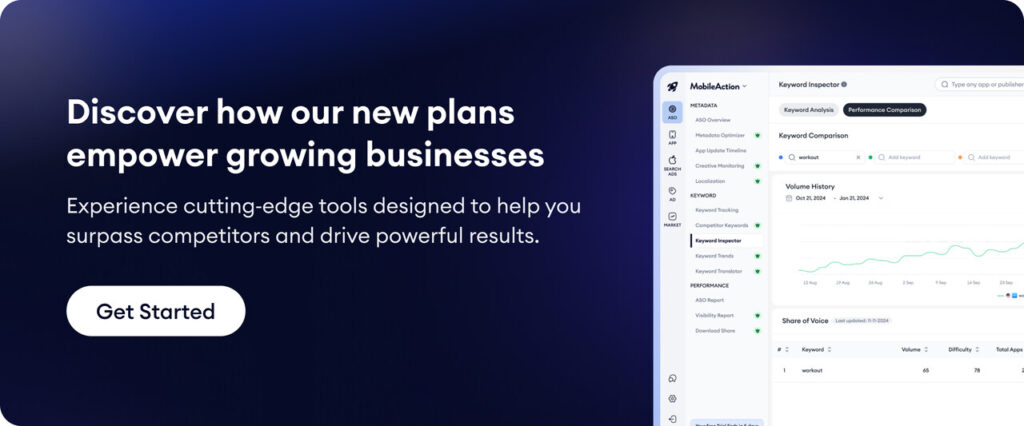So, you read our blog ASO for indie developers: Tactics you should master in 2025, and start to wonder why downloads aren’t pouring in, despite your best efforts.
You’re not alone.
The truth is, today’s App Store and Google Play are crowded — very crowded.
Traditional ASO tactics often focus on a few popular keywords, but this approach leaves a wealth of untapped traffic.
That’s where ASO long-tail optimization comes in. By targeting the long tail of search – those longer, specific phrases users type in – indie developers and savvy marketers can uncover niches that big competitors overlook.
In 2025, ASO long-tail keywords are becoming increasingly important as users search with more specific queries and app store algorithms get better at handling natural language.
Today, we will explore what ASO long-tail optimization means, why it matters more than ever, and how you can leverage it to unlock hidden app store traffic for your app’s success.
What is ASO long-tail optimization?
ASO long tail optimization refers to the practice of focusing your app’s keyword strategy on long-tail keywords – longer, highly specific search phrases – rather than just short, generic terms.
In ASO, just like in web SEO, long-tail keywords target niche user needs. For example, a broad short-tail keyword might be “music app”, whereas a long-tail variant could be “best offline music player for workouts”.
The long-tail phrase is more specific and caters to a particular user intent (in this case, someone who wants a workout-friendly music app that works offline).
Long-tail terms typically have lower search popularity than one or two-word queries, but they are far less competitive and often far more relevant to what a searcher actually wants.
How does this differ from traditional ASO?
Traditional ASO often targets high-volume, short keywords (like “fitness,” “budget,” and “to-do list”) because those terms appear lucrative.
However, everyone else is targeting them too, meaning it’s extremely difficult to rank if you’re not already a top app.
Long-tail optimization flips the script by concentrating on those specific phrases that large apps might ignore.
For instance, instead of trying to rank #1 for “budget app” against finance giants, an indie developer might target “budget app for college students” or “expense tracker for freelancers.”
Fewer people search these exact phrases, but those who do are looking for exactly what your niche app offers. This strategy aligns your app with specific user needs and carves out a space where your app can shine without being overshadowed by big players.
It’s like fishing in a smaller pond where you have a much higher chance of catching a fish, rather than in the ocean where thousands of competitors are casting nets.
Importantly, the rise of voice assistants and natural language search is making long-tail queries more common.
When a user asks Siri or Google Assistant for something, they often use a full sentence or question. For example: “Hey Google, what’s a good free offline music app for iPhone?” – a query that’s firmly long-tail.
Optimizing your app for these detailed searches is the heart of ASO long-tail optimization, and it’s a trend that’s only growing in 2025.
By understanding and implementing this strategy, you ensure that your app’s metadata (title, subtitle, description, keywords) is rich with the phrases that real users are actually searching for.
Key benefits of focusing on long-tail keywords
To summarize the advantages of ASO long tail optimization, here are the key benefits for app discovery:
1. Lower competition
Niche phrases face less competition. This improves your chances of ranking higher in search results, as you’re not up against every top-10 app in your category.
A new puzzle game might struggle to rank for “puzzle game”, but could rank well for “puzzle game for toddlers offline” if that’s relevant to its features.
2. Higher conversion rates
Users who search long-tail terms often know exactly what they want. They’re more likely to install an app that precisely matches their query.
By targeting specific needs (e.g., “meal planner for keto diet”), you attract users who are ready to download when they find the right match.
3. Better user targeting & retention
Long-tail keywords help you reach the users who truly value your app’s niche. This means the users you gain are more likely to stick around.
For example, someone looking for “collaborative to-do list for couples” will likely be delighted to find an app built for that purpose and will engage more, compared to a random user who just typed “to-do list” and might churn quickly if your app isn’t what they had in mind.
Targeting via long-tail leads to an audience that resonates with your app’s core value, boosting retention and engagement.
4. Alignment with user intent
Because these keywords are specific, they capture the intent behind the search. Optimizing for long-tail terms ensures your app appears when the search intent exactly matches what your app does.
This alignment not only improves conversions but also user satisfaction – the user searched for X, found your app that does X, and everyone’s happy.
5. Cumulative discoverability
Each long-tail keyword might be “small” on its own, but by covering many bases, you increase your app’s overall visibility.
Your app becomes discoverable across a wide range of relevant searches.
This diversifies your traffic sources, making your download numbers more resilient. If one keyword’s traffic drops (seasonality or trend changes), you have others to keep you going.
Actionable tips and best practices for long-tail ASO in 2025
To wrap up, here are some actionable tips and best practices to make the most of ASO long-tail optimization in 2025:
-
Prioritize relevance over volume
It can’t be said enough – always choose keywords that closely match your app’s features and audience interests, even if the numbers are modest.
Ten highly targeted downloads beat a hundred random ones that don’t stick around. Think quality, not just quantity.
-
Keep your keyword list fresh
Regularly revisit and update your keywords. The app market moves fast; new trends, technologies, or slang can create new search queries.
For example, a year ago nobody searched “metaverse game,” now it might be a hot term.
Audit your keyword performance every few months and replace it with new long-tail terms that reflect current user language and needs.
-
Use data to guide you
Leverage ASO analytics tools or App Store Connect / Google Play Console data to see which search terms are leading users to your app.
If you notice new phrases, add them to your list. If some keywords aren’t doing anything, replace them. Data-driven iteration is key to honing your long-tail strategy.
-
Organize and cluster keywords
Managing dozens of long-tail keywords can get messy. Use spreadsheets or ASO tools to group related keywords (by feature, intent, etc.).
For instance, group all “work stress” related keywords separately from “5-minute meditation” ones for CalmMind.
This way, you can ensure you cover all subtopics and quickly identify which groups perform best.
-
Localize for different markets
If you’re targeting multiple regions or languages, don’t assume one size fits all. A long-tail keyword that works in the US might not be how users in Spain or India search for the same thing.
Conduct local keyword research for each language or locale you support. For example, the concept of a “cheap eats restaurant app” might be translated to a very different phrase in another language.
By localizing long-tail keywords to regional phrasing and language, you can unlock hidden traffic in each market. This is crucial in 2025 as app usage continues to grow worldwide and non-English searches increase with it.
-
Balance short-tail and long-tail
Long-tail optimization should complement, not completely replace, your core keywords. You still want a few broad terms that define your app, as they help with app store categorization and broad visibility.
Include a mix – maybe 70-80% long-tail focus, 20-30% short-tail basics. This way, you capture niche traffic while still signaling the app’s main genre to the algorithms and users. .
-
Monitor algorithm changes
App stores periodically tweak their search algorithms. Keep an ear to the ground (follow ASO news, forums, and updates from Apple and Google).
If a change occurs (for example, the weighting of app titles vs. keyword fields shifts, or a new search suggestion feature is rolled out), be ready to adapt your strategy.
The fundamentals of long-tail value won’t change, but how you implement might need adjusting with platform changes.
-
Holistic ASO matters
Remember that keywords are one piece of the ASO puzzle. Long-tail optimization will help users find you, but converting them depends on other factors, such as an appealing icon, screenshots, a solid rating, and great app performance.
Make sure your app listing is polished so that when those targeted users land on your page, they’re impressed and hit “Download.”
Also, happy users leaving positive reviews that mention how your app met their specific needs can further reinforce your app’s relevance (and even naturally include additional keywords!).
In short, pair your keyword strategy with a quality product and listing.
By following these best practices, you’ll keep your long-tail ASO strategy sharp and effective through 2025 and beyond.
ASO is an ongoing effort, but the payoff – a steady stream of organic users who truly need your app – is well worth it.
Start unlocking hidden traffic today!
It’s all about working smarter: instead of fighting over the same common keywords, you’re opening up new avenues for users to discover your app.
Long-tail keywords might sound “long-winded,” but they bring laser-focused users straight to you, people actively searching for the exact experience you offer.
The hidden app store traffic locked in those specific searches is yours to capture if you put in the research and optimization effort.
The great news is that long-tail optimization doesn’t require huge budgets or teams – just a deep understanding of your audience and some strategic ASO work.
Whether you’re a solo dev with your first app or a marketing agency looking for an edge, embracing long-tail keywords can level the playing field and drive organic growth.
The app stores are only getting more crowded, so the sooner you start refining your keywords and targeting those niche phrases, the sooner you’ll see results.
Now is the time to act: Begin by reviewing your app’s keywords and ask yourself, are there untapped niches I could target?
Visit MobileAction today and find the package that fits your needs!
Conduct a fresh brainstorming session, use the steps and tips outlined above, and update your ASO strategy for 2025.
You might be surprised at how quickly you can unlock hidden app store traffic and see your downloads climb.
Remember, every big success is built on many small wins – and each long-tail keyword you conquer is one small win towards your app’s greater success. Happy optimizing, and may your long-tail strategy bring you a long tail of success!






